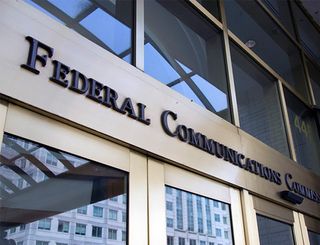FCC Votes to Free up More WiFi Spectrum

The FCC voted 5-0 on what at least three out of the five commissioners called a "paradigm shift" in spectrum policy.
That was on a Report and Order and Further Notice of Proposed Rulemaking to free up 150 MHz of spectrum in that band for WiFi and other uses. Cable operators are looking for all the new WiFi spectrum they can get, since that is their major broadband mobility play.
Now, according to the new three-tired system plan, spectrum will be available for commercial and noncommercial unlicensed use subject to "exclusion zones" to protect incumbent Department of Defense and satellite users. Heretofore that spectrum had been foreclosed because some of it was used by federal agencies— notably DOD radar systems.
Wheeler called it part of a historic week for spectrum management, citing his incentive auction pitch to broadcasters earlier in the week, a two-day FCC seminar on a proposed "model city" test of spectrum sharing this week, and Friday's vote.
Also on the meeting agenda, but withdrawn after it was approved beforehand, was a notice of proposed rulemaking seeking input on potential changes to auction competitive bidding rules.
At a press conference after the meeting, FCC chairman Wheeler declined to comment on whether Dish and the entities it controls, would get the billions in designated entity discounts they had requested, saying the FCC was still collecting information. Criticism of those discounts led, in part, to the issuing of the new public notice on competitive bidding rules in advance of the incentive auction.
Of the 3.5 GHz sharing plan, Rosenworcel said: "Today, we make history. We chart a new course for spectrum policy. That's because in the 3.5 GHz band we adopt a creative three-tiered model for spectrum sharing and management. This is a paradigm shift that paves the way for new services, new technologies and more mobile broadband."
Multichannel Newsletter
The smarter way to stay on top of the multichannel video marketplace. Sign up below.
The minority commissioners did not vote against any portions of the 3.5 Ghz band item, but the did concur in some parts and expressed their reservations about dubbing it that paradigm shift. Commissioner O'Rielly said he was not convinced it was, suggesting that clearing, rather than sharing, was still preferable.
O'Rielly said he was pleased the exclusion zones — where commercial and other operators could not operate to steer clear of that DOD use — had been reduced by 77% from the original proposal, and hoped even those could ultimately accommodate commercial users, something Pai also favors.
While the Democrats were declaring a victory, commissioner Ajit Pai said time would tell, including whether technology can manage dynamic interference protection scenarios. The technology senses vacant channels in real time between priority users — like licensed commercial operators — and allows for unlicensed use on those channels. He also pointed to the exclusion zones, in which 40% of the population resided, which he said was not ideal.
He praised the chairman and majority commissioners for accepting some of his changes to the item including "removing the 20 MHz set-aside that favored certain interests... ensur[ing] that existing wireless Internet service providers can continue to deploy broadband to rural consumers rather than freezing them out during the transition to a new 3.5 GHz regime," and "provid[ing] somewhat greater incentives to invest in the band than were contained in the original draft."
He also said it was time for the FCC to act on its own proposal to free up more spectrum in the 5 GHz band. Potential interference to intelligent transportation system incumbents has been a main sticking point.
The NAB has warned the FCC about using its "flawed" white spaces dynamic access database to attempt to protect against interference in the 3.5 GHz band, but an FCC official suggested Friday that the dynamic access technology would be even more advanced that the one used to manage dynamic access by unlicensed broadband in the TV white spaces.
The FCC says it has addresssed the concerns NAB expressed about flaws in that white spaces database.
Wheeler had signaled last month that he was circulating a draft order that would open up the 3.5 GHz band to spectrum sharing. Rosenworcel also long pushed the FCC to "mine" spectrum in that band.
Wheeler has dubbed 3.5 GHz a potential "innovation band."
A year ago, the FCC proposed creating a new sharing regime it dubbed the Citizens Broadband Radio service, which was another way of saying freeing up underused spectrum with federal users through sharing.
In a blog post, Wheeler outlined the draft, calling it the "three-tiered sharing paradigm": The lowest tier will be open to anyone with an FCC-licensed device and to commercial users at no cost, similar to unlicensed bands. The second, "priority access" tier will require paying for short-term licenses at auction that will provide interference protection from first-tier users. The third tier will include incumbent federal and commercial radar and satellite users, who will receive protection from interference from the other two tiers.
The FCC will use cloud computing technology to coordinate the various tiers and users. "Long gone are the days of an engineer working with pencil and protractor (not to mention pocket protector) to coordinate users into a band," quipped Wheeler.
Initially the FCC planned large buffer zones around military radar users of the band, but Wheeler said that those had been reduced.
Contributing editor John Eggerton has been an editor and/or writer on media regulation, legislation and policy for over four decades, including covering the FCC, FTC, Congress, the major media trade associations, and the federal courts. In addition to Multichannel News and Broadcasting + Cable, his work has appeared in Radio World, TV Technology, TV Fax, This Week in Consumer Electronics, Variety and the Encyclopedia Britannica.

